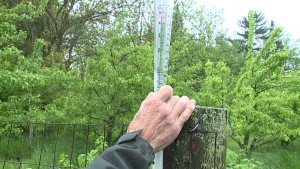By Kelsey Rettke
Farmers face looming insurance deadline as flooding, rain, continues to dominate planting (click here)
Don Young, a farmer in DeKalb and Kane counties, sighed heavily Friday and said he lately feels like a crisis counselor.
“It’s been a very difficult year,” said Young, 50. He also works as a crop insurance agent for Country Financial in Elburn. “For the insurance companies, for farmers, I don’t think anyone ever dreamt that we’d be discussing something like this on this massive scale, Midwest-wide. It’s pretty amazing, not in a good way.”
In addition to working in the crop insurance business for 20 years, Young grows corn and soybeans on 2,100 acres. He said his phone has been ringing off the hook for a week and a half, as farmers in northern Illinois struggle with the effects of one of the wettest springs to date. Farmers face a federal deadline: By Wednesday, they must decide whether to plant their fields and risk low yields in the hope that crop insurance will cover up to 85% of any loss, or face losing 1% of crop insurance coverage each day afterward.
Poor corn and soybean prices could fall further as the U.S. and China impose new tariffs, and torrential rain and flooding has made planting impossible or killed off crops that managed to get into the ground early. In the 18 states that grow most of the nation’s corn, only 58% of the crop had been planted, a far cry from the 90% ordinarily planted by now. In states that grow nearly all soybeans, less than half of the normal crop is planted.
This is Wisconsin.
June 1, 2019
By Aaron Maybin
Left is a rain gauge.
Oak Creek - The storms and rainy weather (click here) are creating challenges for folks in the agriculture industry. Many farmers are far behind schedule and unable to plant crops.
"The money comes in when you go to the farmers market. If you don't have anything to sell, the money is not coming in," said David Kozlowski, farmer.
David Kozlowski admits he's worried....
 These are smaller tractors. If a plow or seeder or cultivator sinks into it's axles in the mud, there is no progress that is going to be made in planting or cultivating the crop.
These are smaller tractors. If a plow or seeder or cultivator sinks into it's axles in the mud, there is no progress that is going to be made in planting or cultivating the crop.Some of the largest farms in the Midwest have tractors and equipment a lot heavier than this. There ability to plant is that much more inhibited.
Sooner or later, the USA's political choices based in guns, god and extremism was going to come home to roost. Welcome to the Climate Crisis. This is not going away. The Republicans are voted into office in the Midwest and for the life of me, I have yet to understand it.
June 2, 2019
By Alex Norton
Corn planting in the U.S. is delayed. (click here) Very delayed. Historically delayed.
As of May 26th, just 58% of the intended 92.8 million acres of corn had been planted. The five-year average pace is 90%, and even last year (that saw a slow start to planting) had gotten caught up to the normal pace by late May. This delay means that roughly 39 million acres are not yet planted (assuming all of the intended acres are still going to be planted to corn is a big stretch). And weather forecasts suggest more delays. Storms have been raging all week in spots across the Corn Belt, bringing rain and powerful winds that are keeping farmers from planting anything.
The market has responded. Prices have been firming all week with more wet weather. Speculative funds have gotten long, rising from a record short position just a month ago (adding fuel to the rally). Even for areas that have not been suffering from the insane wet weather, the support is being felt....
